CHAPTER 5 Solving First Degree Equations in One Variable
5.3 Solve Equations with Variables and Constants on Both Sides
Learning Objectives
By the end of this section, you will be able to:
- Solve an equation with constants on both sides
- Solve an equation with variables on both sides
- Solve an equation with variables and constants on both sides
- Solve equations using a general strategy
Solve an Equation with Constants on Both Sides
You may have noticed that in all the equations we have solved so far, all the variable terms were on only one side of the equation with the constants on the other side. This does not happen all the time—so now we’ll see how to solve equations where the variable terms and/or constant terms are on both sides of the equation.
Our strategy will involve choosing one side of the equation to be the variable side, and the other side of the equation to be the constant side. Then, we will use the Subtraction and Addition Properties of Equality, step by step, to get all the variable terms together on one side of the equation and the constant terms together on the other side.
By doing this, we will transform the equation that started with variables and constants on both sides into the form ![]() . We already know how to solve equations of this form by using the Division or Multiplication Properties of Equality.
. We already know how to solve equations of this form by using the Division or Multiplication Properties of Equality.
EXAMPLE 1
Solve: ![]() .
.
Solution
In this equation, the variable is only on the left side. It makes sense to call the left side the variable side. Therefore, the right side will be the constant side. We’ll write the labels above the equation to help us remember what goes where.
 |
||
| Since the left side is the variable side, the 6 is out of place. We must “undo” adding 6 by subtracting 6, and to keep the equality we must subtract 6 from both sides. Use the Subtraction Property of Equality. |  |
|
| Simplify. |  |
|
| Now all the |
||
| Use the Division Property of Equality. |  |
|
| Simplify. |  |
|
| Check: |  |
|
| Let |
 |
|
 |
||
 |
||
TRY IT 1.1
Solve: ![]() .
.
Show answer
x = −4
TRY IT 1.2
Solve: ![]() .
.
Show answer
a = −8
EXAMPLE 1.2
Solve: ![]() .
.
Solution
Notice that the variable is only on the left side of the equation, so this will be the variable side and the right side will be the constant side. Since the left side is the variable side, the ![]() is out of place. It is subtracted from the
is out of place. It is subtracted from the ![]() , so to ‘undo’ subtraction, add
, so to ‘undo’ subtraction, add ![]() to both sides.
to both sides.
 |
||
| Add 7 to both sides. |  |
|
| Simplify. |  |
|
| The variables are now on one side and the constants on the other. | ||
| Divide both sides by 2. |  |
|
| Simplify. |  |
|
| Check: |  |
|
| Substitute: |
 |
|
 |
||
 |
||
TRY IT 2.1
Solve: ![]() .
.
Show answer
y = 5
TRY IT 2.2
Solve: ![]() .
.
Show answer
m = 9
Solve an Equation with Variables on Both Sides
What if there are variables on both sides of the equation? We will start like we did above—choosing a variable side and a constant side, and then use the Subtraction and Addition Properties of Equality to collect all variables on one side and all constants on the other side. Remember, what you do to the left side of the equation, you must do to the right side too.
EXAMPLE 3
Solve: ![]() .
.
Here the variable, ![]() , is on both sides, but the constants appear only on the right side, so let’s make the right side the “constant” side. Then the left side will be the “variable” side.
, is on both sides, but the constants appear only on the right side, so let’s make the right side the “constant” side. Then the left side will be the “variable” side.
 |
||
| We don’t want any variables on the right, so subtract the |
 |
|
| Simplify. |  |
|
| We have all the variables on one side and the constants on the other. We have solved the equation. | ||
| Check: |  |
|
| Substitute 7 for |
 |
|
 |
||
 |
||
TRY IT 3.1
Solve: ![]() .
.
Show answer
n = 10
TRY IT 3.2
Solve: ![]() .
.
Show answer
c = 1
EXAMPLE 4
Solve: ![]() .
.
Solution
The only constant, ![]() , is on the left side of the equation and variable,
, is on the left side of the equation and variable, ![]() , is on both sides. Let’s leave the constant on the left and collect the variables to the right.
, is on both sides. Let’s leave the constant on the left and collect the variables to the right.
 |
|
| Subtract |
 |
| Simplify. |  |
| We have the variables on the right and the constants on the left. Divide both sides by 2. |  |
| Simplify. |  |
| Rewrite with the variable on the left. |  |
| Check: Let |
|
 |
|
 |
|
 |
|
 |
TRY IT 4.1
Solve: ![]() .
.
Show answer
p = −7
TRY IT 4.2
Solve: ![]() .
.
Show answer
m = −3
EXAMPLE 5
Solve: ![]() .
.
Solution
The only constant, ![]() , is on the right, so let the left side be the variable side.
, is on the right, so let the left side be the variable side.
 |
|
| Remove the |
 |
| Simplify. |  |
| All the variables are on the left and the constants are on the right. Divide both sides by 8. |  |
| Simplify. |  |
| Check: Substitute |
|
 |
TRY IT 5.1
Solve: ![]() .
.
Show answer
j = 2
TRY IT 5.2
Solve: ![]() .
.
Show answer
h = 1
Solve Equations with Variables and Constants on Both Sides
The next example will be the first to have variables and constants on both sides of the equation. As we did before, we’ll collect the variable terms to one side and the constants to the other side.
EXAMPLE 6
Solve: ![]() .
.
Solution
Start by choosing which side will be the variable side and which side will be the constant side. The variable terms are ![]() and
and ![]() . Since
. Since ![]() is greater than
is greater than ![]() , make the left side the variable side and so the right side will be the constant side.
, make the left side the variable side and so the right side will be the constant side.
 |
|
| Collect the variable terms to the left side by subtracting |
 |
| Simplify. |  |
| Now, collect the constants to the right side by subtracting 5 from both sides. |  |
| Simplify. |  |
| The solution is |
|
| Check: Let |
|
 |
TRY IT 6.1
Solve: ![]() .
.
Show answer
x = −1
TRY IT 6.2
Solve: ![]() .
.
Show answer
y = 4
We’ll summarize the steps we took so you can easily refer to them.
HOW TO: Solve an Equation with Variables and Constants on Both Sides
- Choose one side to be the variable side and then the other will be the constant side.
- Collect the variable terms to the variable side, using the Addition or Subtraction Property of Equality.
- Collect the constants to the other side, using the Addition or Subtraction Property of Equality.
- Make the coefficient of the variable
 , using the Multiplication or Division Property of Equality.
, using the Multiplication or Division Property of Equality. - Check the solution by substituting it into the original equation.
It is a good idea to make the variable side the one in which the variable has the larger coefficient. This usually makes the arithmetic easier.
EXAMPLE 7
Solve: ![]() .
.
Solution
We have ![]() on the left and
on the left and ![]() on the right. Since
on the right. Since ![]() >
> ![]() , make the left side the “variable” side.
, make the left side the “variable” side.
 |
|
| We don’t want variables on the right side—add |
 |
| Combine like terms. |  |
| We don’t want any constants on the left side, so add 2 to both sides. |  |
| Simplify. |  |
| The variable term is on the left and the constant term is on the right. To get the coefficient of |
 |
| Simplify. |  |
| Check: Substitute 1 for |
 |
TRY IT 7.1
Solve: ![]() .
.
Show answer
q = 1
TRY IT 7.2
Solve: ![]() .
.
Show answer
n = 1
EXAMPLE 8
Solve: ![]() .
.
Solution
This equation has ![]() on the left and
on the left and ![]() on the right. Since
on the right. Since ![]() >
> ![]() , make the right side the variable side and the left side the constant side.
, make the right side the variable side and the left side the constant side.
 |
|
| Subtract |
 |
| Combine like terms. |  |
| Subtract 8 from both sides to remove the constant from the right. |  |
| Simplify. |  |
| Divide both sides by 3 to make 1 the coefficient of |
 |
| Simplify. |  |
| Check: Let |
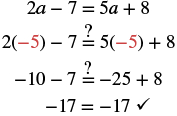 |
Note that we could have made the left side the variable side instead of the right side, but it would have led to a negative coefficient on the variable term. While we could work with the negative, there is less chance of error when working with positives. The strategy outlined above helps avoid the negatives!
TRY IT 8.1
Solve: ![]() .
.
Show answer
a = −5
TRY IT 8.2
Solve: ![]() .
.
Show answer
k = −6
To solve an equation with fractions, we still follow the same steps to get the solution.
EXAMPLE 9
Solve: ![]() .
.
Solution
Since ![]() >
> ![]() , make the left side the variable side and the right side the constant side.
, make the left side the variable side and the right side the constant side.
 |
|
| Subtract |
 |
| Combine like terms. |  |
| Subtract 5 from both sides. |  |
| Simplify. |  |
| Check: Let |
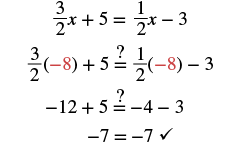 |
TRY IT 9.1
Solve: ![]() .
.
Show answer
x = 10
TRY IT 9.2
Solve: ![]() .
.
Show answer
y = −3
We follow the same steps when the equation has decimals, too.
EXAMPLE 10
Solve: ![]() .
.
Solution
Since ![]() >
> ![]() , make the left side the variable side and the right side the constant side.
, make the left side the variable side and the right side the constant side.
 |
|
| Subtract |
 |
| Combine like terms. |  |
| Subtract 4 from both sides. |  |
| Simplify. |  |
| Use the Division Property of Equality. |  |
| Simplify. |  |
| Check: Let |
 |
TRY IT 10.1
Solve: ![]() .
.
Show answer
x = −5
TRY IT 10.2
Solve: ![]() .
.
Show answer
y = −5
Solve Equations Using a General Strategy
Each of the first few sections of this chapter has dealt with solving one specific form of a linear equation. It’s time now to lay out an overall strategy that can be used to solve any linear equation. We call this the general strategy. Some equations won’t require all the steps to solve, but many will. Simplifying each side of the equation as much as possible first makes the rest of the steps easier.
HOW TO: Use a General Strategy for Solving Linear Equations
- Simplify each side of the equation as much as possible. Use the Distributive Property to remove any parentheses. Combine like terms.
- Collect all the variable terms to one side of the equation. Use the Addition or Subtraction Property of Equality.
- Collect all the constant terms to the other side of the equation. Use the Addition or Subtraction Property of Equality.
- Make the coefficient of the variable term to equal to
 . Use the Multiplication or Division Property of Equality. State the solution to the equation.
. Use the Multiplication or Division Property of Equality. State the solution to the equation. - Check the solution. Substitute the solution into the original equation to make sure the result is a true statement.
EXAMPLE 11
Solve: ![]() .
.
Solution
 |
|
| Simplify each side of the equation as much as possible. Use the Distributive Property. |
 |
| Collect all variable terms on one side of the equation—all |
|
| Collect constant terms on the other side of the equation. Subtract 6 from each side |
 |
| Simplify. |  |
| Make the coefficient of the variable term equal to 1. Divide each side by 3. |  |
| Simplify. |  |
| Check: Let |
 |
TRY IT 11.1
Solve: ![]() .
.
Show answer
x = 4
TRY IT 11.2
Solve: ![]() .
.
Show answer
y = 1
EXAMPLE 12
Solve: ![]() .
.
Solution
 |
|
| Simplify each side of the equation as much as possible by distributing. The only |
 |
| Add 5 to both sides to get all constant terms on the right side of the equation. |  |
| Simplify. |  |
| Make the coefficient of the variable term equal to 1 by multiplying both sides by -1. |  |
| Simplify. |  |
| Check: Let |

|
TRY IT 12.1
Solve: ![]() .
.
Show answer
y = −6
TRY IT 12.2
Solve: ![]() .
.
Show answer
z = 8
EXAMPLE 13
Solve: ![]() .
.
Solution
 |
|
| Simplify each side of the equation as much as possible. Distribute. |
 |
| Combine like terms |  |
| The only |
|
| Add 3 to both sides to get all constant terms on the other side of the equation. |  |
| Simplify. |  |
| Make the coefficient of the variable term equal to 1 by dividing both sides by 4. |  |
| Simplify. |  |
| Check: Let |
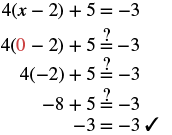 |
TRY IT 13.1
Solve: ![]() .
.
Show answer
a = 2
TRY IT 13.2
Solve: ![]() .
.
Show answer
n = 2
EXAMPLE 14
Solve: ![]() .
.
Solution
Be careful when distributing the negative.
 |
|
| Simplify—use the Distributive Property. |  |
| Combine like terms. |  |
| Add 2 to both sides to collect constants on the right. |  |
| Simplify. |  |
| Divide both sides by −6. |  |
| Simplify. |  |
| Check: Let |
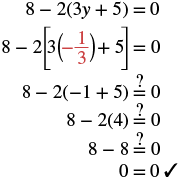 |
TRY IT 14.1
Solve: ![]() .
.
Show answer
![]()
TRY IT 14.2
Solve: ![]() .
.
Show answer
![]()
EXAMPLE 15
Solve: ![]() .
.
Solution
 |
|
| Distribute. |  |
| Combine like terms. |  |
| Subtract |
 |
| Simplify. |  |
| Subtract 9 to get the constants on the left. |  |
| Simplify. |  |
| Divide by 5. |  |
| Simplify. |  |
| Check: Substitute: |
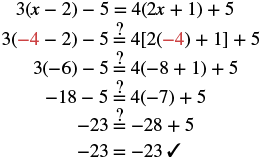 |
TRY IT 14.1
Solve: ![]() .
.
Show answer
p = −2
TRY IT 14.2
Solve: ![]() .
.
Show answer
q = −8
EXAMPLE 15
Solve: ![]() .
.
Solution
 |
|
| Distribute. |  |
| Add |
 |
| Simplify. |  |
| Add 1 to get constants on the right. |  |
| Simplify. |  |
| Divide by 4. |  |
| Simplify. |  |
| Check: Let |
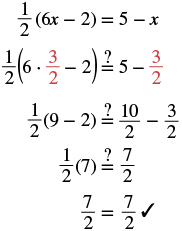 |
TRY IT 15.1
Solve: ![]() .
.
Show answer
u = 2
TRY IT 15.2
Solve: ![]() .
.
Show answer
x = 4
In many applications, we will have to solve equations with decimals. The same general strategy will work for these equations.
EXAMPLE 16
Solve: ![]() .
.
Solution
 |
|
| Distribute. |  |
| Subtract |
 |
| Simplify. |  |
| Subtract 1.2 to get the constants to the right. |  |
| Simplify. |  |
| Divide. |  |
| Simplify. |  |
| Check: Let |
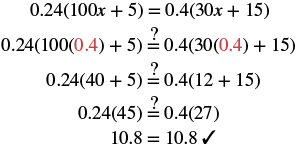 |
TRY IT 16.1
Solve: ![]() .
.
Show answer
1
TRY IT 16.2
Solve: ![]() .
.
Show answer
−1
Key Concepts
- Solve an equation with variables and constants on both sides
- Choose one side to be the variable side and then the other will be the constant side.
- Collect the variable terms to the variable side, using the Addition or Subtraction Property of Equality.
- Collect the constants to the other side, using the Addition or Subtraction Property of Equality.
- Make the coefficient of the variable 1, using the Multiplication or Division Property of Equality.
- Check the solution by substituting into the original equation.
- General strategy for solving linear equations
- Simplify each side of the equation as much as possible. Use the Distributive Property to remove any parentheses. Combine like terms.
- Collect all the variable terms to one side of the equation. Use the Addition or Subtraction Property of Equality.
- Collect all the constant terms to the other side of the equation. Use the Addition or Subtraction Property of Equality.
- Make the coefficient of the variable term to equal to 1. Use the Multiplication or Division Property of Equality. State the solution to the equation.
- Check the solution. Substitute the solution into the original equation to make sure the result is a true statement.
Practice Makes Perfect
Solve an Equation with Constants on Both Sides
In the following exercises, solve the equation for the variable.
| 1. |
2. |
| 3. |
4. |
| 5. |
6. |
| 7. |
8. |
| 9. |
10. |
| 11. |
12. |
Solve an Equation with Variables on Both Sides
In the following exercises, solve the equation for the variable.
| 13. |
14. |
| 15. |
16. |
| 17. |
18. |
| 19. |
20. |
| 21. |
22. |
| 23. |
24. |
Solve an Equation with Variables and Constants on Both Sides
In the following exercises, solve the equations for the variable.
| 25. |
26. |
| 27. |
28. |
| 29. |
30. |
| 31. |
32. |
| 33. |
34. |
| 35. |
36. |
| 37. |
38. |
| 39. |
40. |
| 41. |
42. |
| 43. |
44. |
| 45. |
46. |
| 47. |
48. |
| 49. |
50. |
Solve an Equation Using the General Strategy
In the following exercises, solve the linear equation using the general strategy.
| 51. |
52. |
| 53. |
54. |
| 55. |
56. |
| 57. |
58. |
| 59. |
60. |
| 61. |
62. |
| 63. |
64. |
| 65. |
66. |
| 67. |
68. |
| 69. |
70. |
| 71. |
72. |
| 73. |
74. |
| 75. |
76. |
| 77. |
78. |
| 79. |
80. |
| 81. |
82. |
| 83. |
84. |
| 85. |
86. |
Everyday Math
| Making a fence 87. Jovani has a fence around the rectangular garden in his backyard. The perimeter of the fence is |
Concert tickets 88. At a school concert, the total value of tickets sold was |
| Coins 89. Rhonda has |
Fencing 90. Micah has |
Writing Exercises
| 91. When solving an equation with variables on both sides, why is it usually better to choose the side with the larger coefficient as the variable side? | 92. Solve the equation |
| 93. What is the first step you take when solving the equation |
94. Solve the equation |
| 95. Using your own words, list the steps in the General Strategy for Solving Linear Equations. | 96. Explain why you should simplify both sides of an equation as much as possible before collecting the variable terms to one side and the constant terms to the other side. |
Answers
| 1. 6 | 3.6 | 5. -8 |
| 7. -8 | 9. -4 | 11. -2 |
| 13. -11 | 15. 9 | 17. -3 |
| 19. 3 | 21. -3/4 | 25. 19 |
| 27. 7 | 29. -5 | 31. -4 |
| 33. 2 | 35. 4 | 37. -6 |
| 39. 7 | 41. -40 | 43. 15 |
| 45. 3.46 | 47. 60 | 49. 23 |
| 51. 9 | 53. 6 | 55. 3 |
| 57. −2 | 59. −1 | 61. 5 |
| 63. 0.52 | 65. 0.25 | 67. −9 |
| 69. 2 | 71. 6 | 73. 3/2 |
| 75. 3 | 77. −4 | 79. 2 |
| 81. 34 | 83. 10 | 85. 2 |
| 87. 30 feet | 89. 8 nickels | 91. Answers will vary. |
| 93. Answers will vary. | 95. Answers will vary. |
Attributions
This chapter has been adapted from “Solve Equations with Variables and Constants on Both Sides” in Prealgebra (OpenStax) by Lynn Marecek, MaryAnne Anthony-Smith, and Andrea Honeycutt Mathis, which is under a CC BY 4.0 Licence. Adapted by Izabela Mazur. See the Copyright page for more information.




